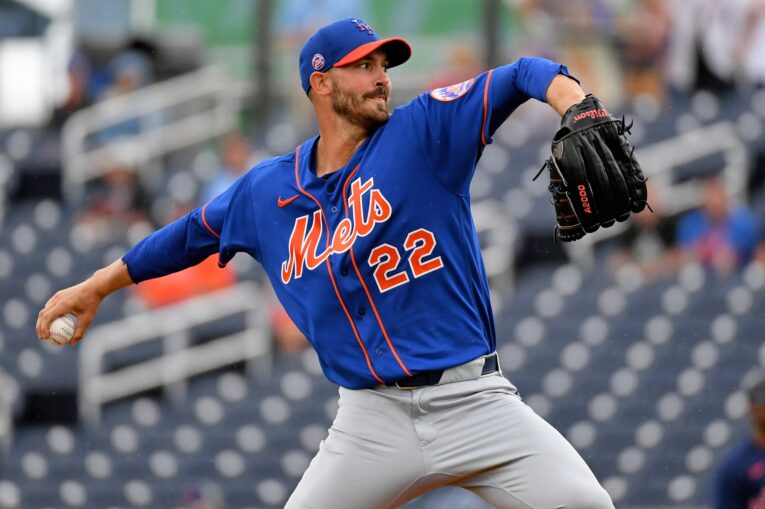
This offseason, the New York Mets essentially replaced Zack Wheeler — departed in free agency to Philadelphia — in their starting rotation with veteran right-handers Michael Wacha and Rick Porcello.
Both were inked to one-year deals, $10 million for Porcello, with Wacha’s $3 million contract laden with appearance-based incentives. In so many words, the fifth starter’s job was Porcello’s to lose and Wacha was penciled in as a potential swingman.
Over four exhibition outings this spring, the 31-year-old New Jersey native pitched to a 2.53 ERA with eight strikeouts and a walk over 10.2 innings. That’s a good start. Porcello has always been a control guy (3.18 strikeouts-to-walks over his career), and it hadn’t appeared he’d lost his touch.
Wacha’s one earned run over 7.2 Spring Training innings (five strikeouts, four walks) was promising, but Porcello more than likely had a leg up in the competition.
Then came COVID-19, and then Noah Syndergaard‘s torn UCL, and now here we are. It’s July 3 — three weeks until Re-Opening Day — and both Wacha and Porcello seemed destined for the back-end of the Mets rotation.
Let’s say Wacha can hold down the fifth spot respectably and provide average value — could be a stretch, but let’s go with it. That leaves Matz — who really found his groove in the second half (1.94 ERA over seven starts from August 7 to Sept 11) — and Porcello — who also righted the ship towards the end of the year — shoulder the Metsies’ mid-rotation load.
It’s not an ideal situation considering the star-studded rotation general manager Brodie Van Wagenen had assembled heading into camp — Jacob deGrom, Syndergaard, Marcus Stroman, Steven Matz, and a combination of Porcello and Wacha were a talented, intriguing bunch — but there’s no reason to panic now that the parameters have changed.
Porcello, far removed from his 2016 American League Cy Young Award, struggled mightily over the course of last season, pitching to a 5.83 ERA over his first 29 starts (157.1 innings) with 123 strikeouts and 44 walks.
As told to Mike Puma of the New York Post earlier this week, one MLB talent evaluator said of Porcello, “I think part of his problem last year is he got caught up in trying to go the analytics route and pitch to the top of the strike zone with a four-seamer and he’s always been a sinker and two-seam guy”.
Last season, 130 of the 164 hits Porcello allowed on pitches in the strike zone came on balls in the middle of the zone or higher.
His four-seamer and two-seamer were certainly hit hard throughout the year — 46 percent and 38 percent hard-hit rates, respectively — but Porcello’s secondary pitches — his slider, changeup, and curveball — induced much weaker contact (29 percent, 35 percent, and 30 percent, respectively). That’s encouraging.
“He got away from his strength. I think he got two-thirds of the way through the season and he realized that ‘This isn’t working, I have to go back to what helped create success.’.” the scout added. “I think he went back to using his two-seamer and he finished stronger and got a better result. I think he’s probably learned a lesson from that and he’s going to go back to his strengths instead of trying to create something that he’s not.”
Judging by his 2019 game logs, that realization may have come for Porcello in August. After a putrid July (7.94 ERA over five starts), August was much kinder to the West Orange product (4.00 ERA over five starts). Progress is always good.
His first two outings in September were largely forgettable (12 earned runs over eight innings combined), but over his last three starts, something definitely seemed to click for the right-hander.
Over 17 innings of work from September 15 through his final start on September 25, Porcello pitched to a 2.65 ERA with a .222/.258/.302 batting line against, 20 strikeouts, and just one walk.
Whether that was a back-to-basics shift in philosophy for Porcello, or simply a change in fortune, as evidenced by his strong 2020 spring, it appears to have gotten the veteran hurler back on track.
With a sprint to the finish line in arguably the toughest divisional (and intra-divisional) alignment in the majors, an effective Rick Porcello could go a long way in making this wacky season a memorable one — for the right reasons, of course — for the Mets.















